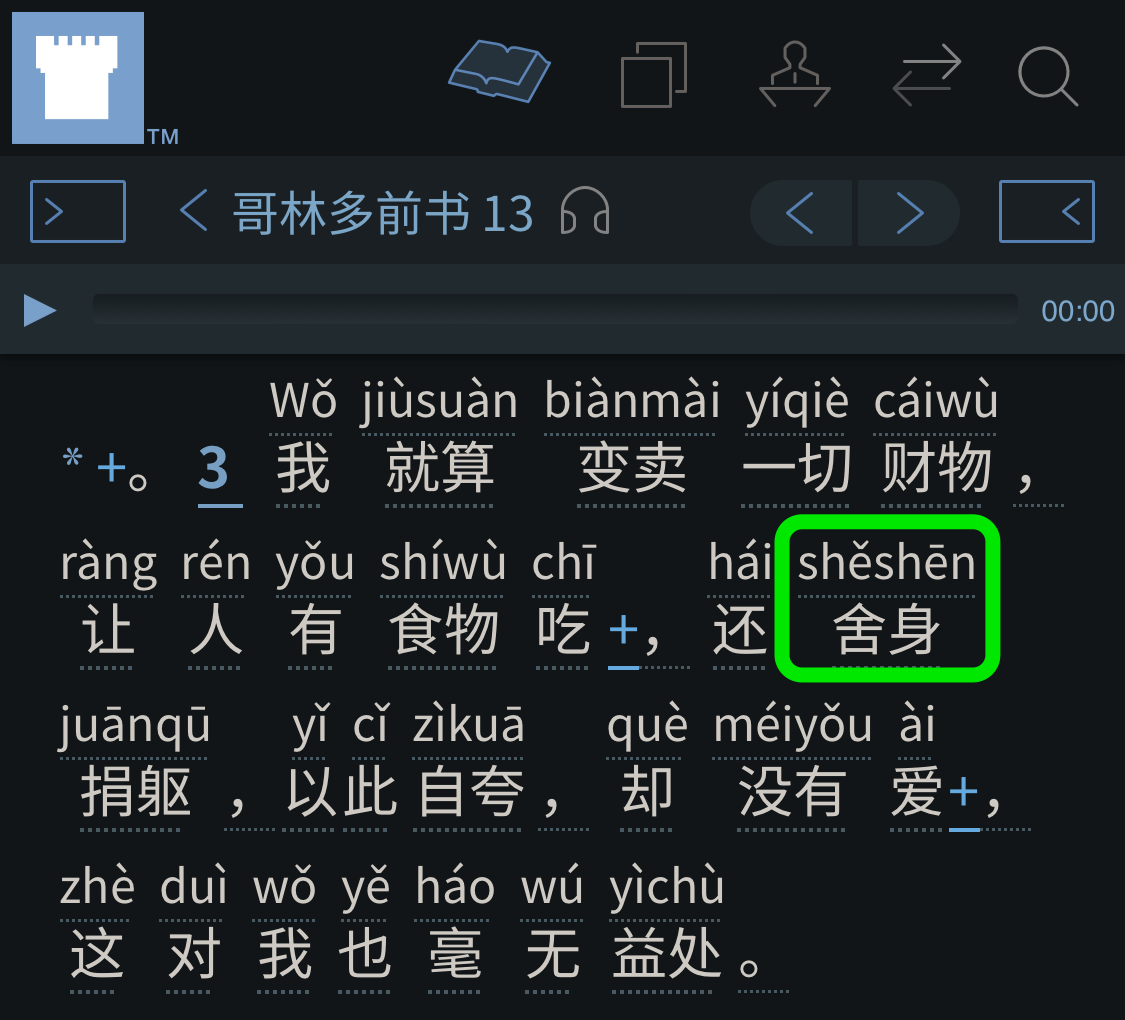shěshēn (shě·shēn {give up}; abandon · {body [→ [life]]} [→ [give/sacrifice one’s life/oneself | become a monk (Buddhism)]] 舍身 捨身) ← Tap/click to show/hide the “flashcard”
[Notes: Tap/click on a Pīnyīn (Pīn·yīn {Piecing Together of} · Sounds → [Pinyin] 拼音) expression to reveal its “flashcard”; tap/click on a “flashcard” or its Pīnyīn (Pīn·yīn {Piecing Together of} · Sounds → [Pinyin] 拼音) expression to hide the “flashcard”. 📖 📄 📘 icons mean 📖 Reveal All, 📄 Reveal Advanced, and 📘 Reveal None re all the “flashcards” in the heading, paragraph, etc. that they are placed at the beginning of.]
I have long especially liked 1 Corinthians 13. It contains counsel on what really does and doesn’t matter in life, an extensive description and definition of the most important kind of love, and a sublime discussion about the need to become complete, mature, as a person. As these apply to life in general, so too do they apply to our lives as Mandarin field language learners.
As Mandarin field language learners, it can benefit us greatly to consider what we can learn from 1 Corinthians 13, and along the way, we can also consider some of the Mandarin expressions used in that chapter in the current version of the Mandarin New World Translation Bible (nwtsty).
“If I Hand Over My Body…”
This week’s MEotW, “shěshēn (shě·shēn {give up}; abandon · {body [→ [life]]} [→ [give/sacrifice one’s life/oneself | become a monk (Buddhism)]] 舍身 捨身)”, is used in verse 3 (WOL, Pīnyīn (Pīn·yīn {Piecing Together of} · Sounds → [Pinyin] 拼音) Plus) of 1 Corinthians 13:

(Dark mode for the Watchtower ONLINE LIBRARY (WOL) website, as shown in the above image, can be enabled in the Safari web browser by using the Noir Safari extension.)
In “shěshēn (shě·shēn {give up}; abandon · {body [→ [life]]} [→ [give/sacrifice one’s life/oneself | become a monk (Buddhism)]] 舍身 捨身)”, “shě ({give up}; abandon 舍 捨/舍/捈)” means “give up; abandon”. As for “shēn (body [→ [self]] 身)”, it literally means “body”, and is sometimes used to effectively mean “self”, as the MEotW post on “shēn (body → [self] 身)‐lín ({being present (in)} 临 臨)‐qí (his/her/its/their… 其)‐jìng ({(set of) boundaries → [(bounded) place; area] → [condition; situation; circumstances]} 境)” pointed out:
In “shēn (body → [self] 身)‐lín ({being present (in)} 临 臨)‐qí (his/her/its/their… 其)‐jìng ({(set of) boundaries → [(bounded) place; area] → [condition; situation; circumstances]} 境)”, “shēn (body [→ [self]] 身)”, which literally means “body”, is used to effectively mean “self”. Another Mandarin expression in which “shēn (body [→ [self]] 身)” is used this way is “xiànshēn (xiàn·shēn {offer → [dedicate]} · {body → [self]} | {offering of → [dedicating of]} · {body → [self]} → [dedication] 献身 獻身)”, which literally means “offer body”, but which effectively means “dedicate self”, as one does before getting baptized.
However, it seems that “shēn (body [→ [self]] 身)” is used in 1 Corinthians 13:3 to actually mean “body”, especially considering that the English translation of the phrase it appears in is “hand over my body”:
And if I give all my belongings to feed others, and if I hand over my body so that I may boast, but do not have love, I do not benefit at all.
📖 📄 📘 Wǒ (I 我) jiùsuàn (jiù·suàn {even if} · {figuring → [considering]} 就算) biànmài (biàn·mài changing · sell → [sell off] 变卖 變賣) yíqiè (yí·qiè {one (whole)} · {corresponding (set of)} → [all] 一切) cáiwù (cái·wù (my) wealth · things → [(my) belongings] 财物 財物), ràng ({to allow} 让 讓) rén (people 人) yǒu ({to have} 有) shíwù (shí·wù eating · matter → [food] 食物) chī ({to eat} 吃 吃/喫), hái (also 还 還) shěshēn (shě·shēn {give up} · {(my) body} 舍身 捨身) juānqū (juān·qū {relinquish → [contribute]} · {(my) human body} 捐躯 捐軀), yǐcǐ (yǐ·cǐ using · this 以此) zìkuā (zì·kuā {(about) self} · {to boast} 自夸 自誇), què (but 却 卻) méiyǒu (méi·yǒu not · {do have} 没有 沒有) ài (love 爱 愛), zhè (this 这 這) duì (towards → [to] 对 對) wǒ (me 我) yě (even 也) háowú (háo·wú {(even) a fine hair (of)} · {does not have} → [does not have even a little] 毫无 毫無) yìchu (yì·chu beneficial · place → [benefit] 益处 益處).
In other contexts, “shěshēn (shě·shēn {give up}; abandon · {body [→ [life]]} [→ [give/sacrifice one’s life/oneself | become a monk (Buddhism)]] 舍身 捨身)” could effectively mean “give/sacrifice one’s life/oneself”, or, as used by Buddhists, “become a monk”.
“…So That I May Boast”?
Some Mandarin field language learners may feel that they deserve credit (and maybe a little glory) for the blood, sweat, and tears they have shed to acquire extensive knowledge of the Chinese characters. Perhaps so, but the taking of such pains is not in itself a guarantee that what these pains were taken for is completely and truly worthy and commendable. Colossians 2:23 comes to mind:
Although those things have an appearance of wisdom in a self-imposed form of worship and a false humility, a harsh treatment of the body, they are of no value in combating the satisfying of the flesh.
In other words, just because something is hard, that doesn’t necessarily mean that it’s good, or was done with good motive, whether that something involves spiritual things, like Paul was speaking of, or technical matters such as which writing system technology to use in a particular situation.
Yes, Chinese characters are hard, and they are the traditionally used writing system for Mandarin Chinese, so a certain amount of hard work may be needed at times to learn (and sometimes relearn) certain Chinese characters if one is to function well in the Mandarin field, and many Mandarin field language learners have shown love by being willing to put in the necessary effort in such situations. However, in other situations, such as when an easier alternative like Pīnyīn (Pīn·yīn {Piecing Together of} · Sounds → [Pinyin] 拼音) is readily available, as is becoming more and more the case these days, what would be proved by continuing to bash one’s head against the Great Wall of Chinese characters when it’s not actually necessary?
Besides, as linguists (language scientists) and God’s Word the Bible (at 1 Corinthians 14:8–11) both tell us, what’s really of primary importance in how we use language in God’s service is, not writing systems like Chinese characters, but understandable speech. With points like the above in mind, let us continue to make sure that we are using our precious, limited, dedicated time well, out of love, and not just so that we may “boast”.

Why keep bashing your head against the Great Wall of characters when Pīnyīn (Pīn·yīn {Piecing Together of} · Sounds → [Pinyin] 拼音) makes available a way around it?